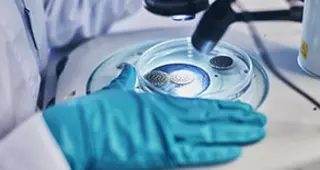The BAS™ biological wastewater treatment process is the optimally designed combination of MBBR and activated sludge processes.
Overview
AnoxKaldnes™ BAS™, Biological Activated Sludge process, is a combination of Moving Bed Biofilm Reactor (MBBR) technology with conventional activated sludge (AS).MBBR is a biological wastewater treatment process that utilizes specialized polyethylene carriers (media) to create a large protected surface on which biofilm can attach. The media is mixed in the reactor, and the large surface area provides more treatment capacity in a smaller volume compared to conventional treatment methods.MBBR technology is known for providing efficient, stable and robust treatment in a small footprint.MBBR systems are well suited for customization based on site-specific conditions and they can be combined with a variety of solids removal technologies to achieve low effluent suspended solids.
There are many advantages of utilizing MBBR technology up front of an existing AS system including extending the capacity of the existing AS system, protecting the AS system from high organic or toxic loads, improving the efficiency of the AS system and improving the AS effluent sludge characteristics.Bringing an MBBR in as an upgrade to an existing AS system allows the plant to upgrade with little disturbance while increasing the overall treatment efficiency.
MBBR technology is capable of meeting very strict effluent demands of organics and nitrogen. A typical BAS system, however, is often designed to act as a buffer or shield for the existing AS plant and is thereby usually designed to remove 50-70% of the organics coming into the system.
AnoxKaldnes™ BAS™ for nutrient rich wastewaters
An activated sludge process is often efficient and may produce satisfactory results.However, when subjected to varying conditions, such as organic loading, the system may become unstable and result in conditions such as sludge bulking.
In the AnoxKaldnesTM BAS biological process, the MBBR pre-treatment removes much of the easily biodegradable COD and also acts as a buffer to protect the AS system from peak loads.This promotes a stable and more efficient activated sludge process with improved sludge settling characteristics.
AnoxKaldnes™ BAS™ for nutrient limited wastewaters
For wastewater that is nutrient limited, applying the AnoxKaldnes patented nutrient limited BAS principle is a solution that enhances efficiency, effluent quality and sludge characteristics.
The performance of the AS stage is improved if the MBBR is operated under conditions that are nutrient limited.Nutrient limited conditions results in a biofilm that limits reproduction and rather produces extracellular polysaccharides (EPS).The EPS-rich biomass passes through the MBBR and becomes a readily available food source for the microorganisms in the activated sludge step.Consumption of EPS-rich biomass has been shown to improve sludge characteristics as well as reduce the sludge production.
Since 1986 AnoxKaldnes has brought a deep knowledge of microbiology and cutting edge biological solutions to the market.The BAS treatment process was developed by AnoxKaldnes based on modern biotechnological principles and the MBBR technology.Due to its many advantages, the AnoxKaldnes BAS process has been used to upgrade or even replace conventional activated sludge systems.The process has been successfully applied worldwide across municipal and most industrial sectors and over a wide range of plant sizes.
Benefits
- Small footprint
- Stable and robust
- Improved sludge characteristics
- Low sludge production
- Low nutrient discharge
- Enhanced nitrification
Applications
- Pulp and paper mills
- Oil & gas and petrochemical
- Food and beverage
- Pharmaceutical
- Chemical
- Municipalities





